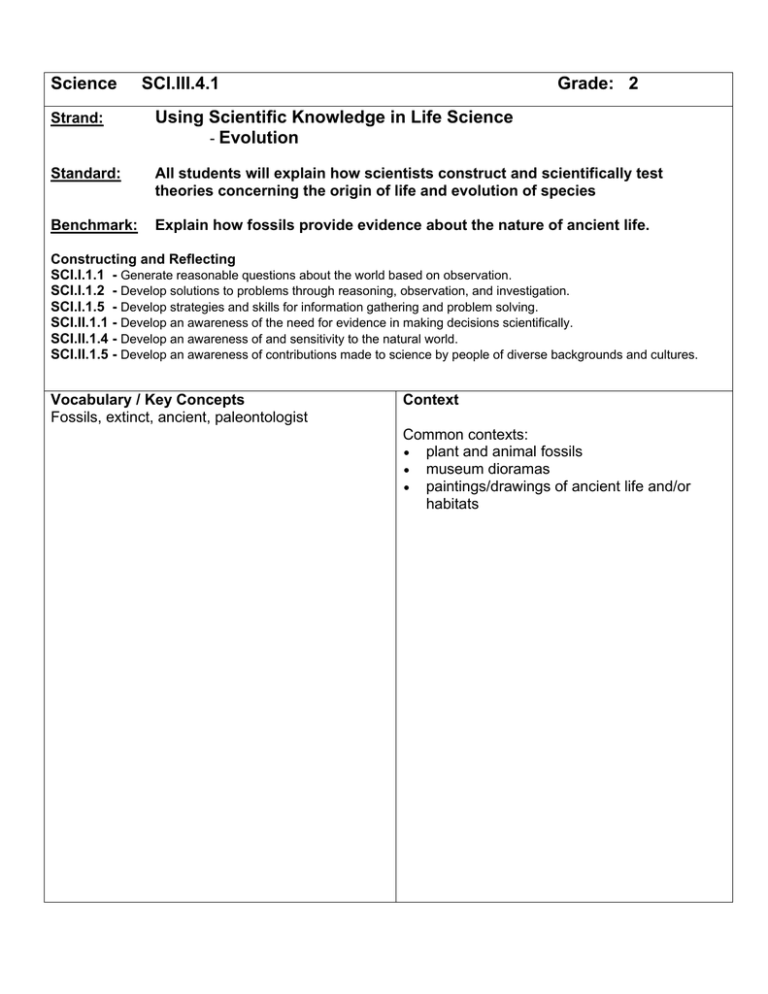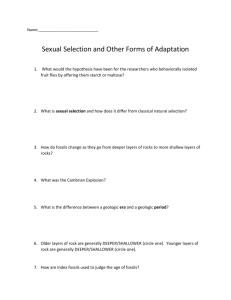Science SCI.III.4.1 Grade: 2
advertisement

Science SCI.III.4.1 Grade: 2 Strand: Using Scientific Knowledge in Life Science - Evolution Standard: All students will explain how scientists construct and scientifically test theories concerning the origin of life and evolution of species Benchmark: Explain how fossils provide evidence about the nature of ancient life. Constructing and Reflecting SCI.I.1.1 - Generate reasonable questions about the world based on observation. SCI.I.1.2 - Develop solutions to problems through reasoning, observation, and investigation. SCI.I.1.5 - Develop strategies and skills for information gathering and problem solving. SCI.II.1.1 - Develop an awareness of the need for evidence in making decisions scientifically. SCI.II.1.4 - Develop an awareness of and sensitivity to the natural world. SCI.II.1.5 - Develop an awareness of contributions made to science by people of diverse backgrounds and cultures. Vocabulary / Key Concepts Fossils, extinct, ancient, paleontologist Context Common contexts: • plant and animal fossils • museum dioramas • paintings/drawings of ancient life and/or habitats Knowledge and Skills Benchmark Clarification: Scientists who find and use fossils to create an understanding of the past are paleontologists. A fossil is one of many tools used by scientists to study the history of life on Earth. Fossils can take many forms: • An impression of a dead plant or animal that has been replaced by minerals • A cast formed by filling in spaces left from footprints or decaying bodies • A mold, plant, or animal trapped in tree sap (amber) • A preserved specimen of life from a specific time Students will: Identify the following types of fossils: 1. An impression of a dead plant or animal that has been replaced by minerals 2. A mold of a footprint or a decaying body that has been filled in with sand / clay 3. A fragment / whole animal that has been trapped in tree sap Resources Coloma Resources: Newbridge Early Science Program: “The Big Bears” Teaching Manual and Big Book “Animals in Hiding” Teacher’s Manual and Big Book “The World of Dinosaurs” Pgs 6 & & (Teacher’s Manual) Diorama pg 13) Robins - book Diggins - book Play Dough - experiment Cups – goes with above experiment Creepy Crawlies - book Fossil Collection - book Fossil Kit - activity Mix Up Chameleon - book • • Match fossils with the time period when they were most likely formed • Explain another tool scientists use to study the history of life on Earth Other Resources: Museum of Paleontology – UC Berkeley http://www.ucmp.berkeley.edu/ Dinosaur Thematic Unit – EXCELLENT – lots of info, activities, resources – very teachable! http://www.libsci.sc.edu/miller/Dinosaurs.htm ------------------------------------------------------------------------------ USGS – Fossils and Biographies of scientists http://www.npwrc.usgs.gov/resource/1998/agate/p ale.htm Dinosaur integrated unit from Southwest Educational Development Laboratory – EXCELLENT RESOURCE – with Spanish translations. http://www.sedl.org/scimath/pasopartners/dinos aurs/welcome.html “Changes over Time.” A Second Grade Unit by the Battle Creek Area Mathematics & Science Standards. “Fossils, Fossils.” Sing the Science Standards (Songbook/CD). http://scienceexplosion.indiegroup.com/ ReachOut Michigan – make your own fossil print with salt dough. http://www.reachoutmichigan.org/funexperiment s/quick/fossilprint.html Anning, Mary. http://teacher.scholastic.com/literacyplace/ UC Berkeley – Biography – Mary Anning http://www.ucmp.berkeley.edu/history/anning.ht ml Other Resources (continued from column at right.) Instruction Assessment INSTRUCTION Focus Question: How are Earth’s layers used to determine the age of a fossil? ASSESSMENT The teacher will collect and redistribute cups, making sure that students do not receive their own cups. Students will open their cups by Begin by reading a biography about Mary Anning. carefully tearing them down the sides. Students should carefully explore the shapes Students will create a model of fossil layers similar to and patterns that were made by their casts. the Earth’s. Each pair of students will use With a cautious approach, students may be approximately one-third of a can of play dough (all able to keep the molds of their specimens one color or three separate colors) and two small intact. The teacher will ask students which items (twigs, leaves, bark, seeds, dead insects, fruit specimens made a good impression or rinds, chicken bones, small shells, or small plastic disintegrated, and which lived at an earlier insects) to make fossil layers in a paper cup. time or lived later. Students will draw conclusions and present their findings based Guide students through the following steps: Put one- on their observations. third of the play dough in the bottom of the cup, put a (Give students rubric before activity.) specimen on top of the play dough, cover it with Scoring Rubric another one-third of the play dough and press, put the second specimen on top of this layer, and cover Criteria: Identification of layers with the remaining one-third of the play dough and Apprentice -Recognizes that objects were buried at press. different levels (layers). Students then will discuss which layers in the cup Basic-Locates at least two distinct layers. are the oldest and youngest. Students will explain Meets -Locates all layers and finds evidence of fossils. how this activity is similar to the idea that the age of Exceeds -Locates all layers and explains that fragile a fossil layer is determined by the order in which it materials disintegrate and therefore not all plants and animals from the past made fossils. was formed. Criteria: Demonstration of scientific methods Apprentice -Preserves some evidence of the layers. Basic-Preserves layers and some of the casts. Meets -Preserves the layers and the casts. Exceeds -Works meticulously like a paleontologist and identifies the specimens precisely. Criteria: Accuracy of relationships Apprentice -Explains that some plants/animals lived a long time ago. Basic-Recognizes that fossils exist within layers of the Earth. Meets -Describes the relationship between layers and the age of specimens. Exceeds -Provides evidence that not all members of a species (i.e., dinosaurs) became extinct at once -orLinks climate and other natural disasters with fossil findings. Teacher Notes: http://www.misd.net/mibig/ Explain how scientists construct and scientifically test theories concerning the origin of life and evolution of species. Are there patterns of similarity among organisms alive today? Are there relationships among organisms that lived in the past and organisms alive today? Where did humans come from in the history of the world? What is the evidence that might give us some clues to these questions? Many students come to the science classroom with strongly held beliefs that don't allow them to openly examine the scientific explanations to these questions. The challenge in the science classroom is to help students distinguish between a scientist's way of thinking and understanding from those practiced by some theologians, poets, or philosophers. Students need working definitions of key terms with clear examples to provide a framework for their thinking. This should help them demarcate where science begins and ends. Words such as fact, theory, hypothesis, and law are terms students encounter in casual conversation in everyday life. In science these terms have a very specific meaning. A fact is an observation that has been repeatedly confirmed but facts can change. It was a scientific fact for many years that human cells had 24 pairs of chromosomes. Improved techniques of microscopy revealed that they actually have 23 pairs. People commonly use the word theory to mean a "guess" or "hunch". "My theory is..." in common usage would be better stated as "My hypothesis is....". In science, a hypothesis is a testable statement about the natural world. A theory, in science, is a well-substantiated explanation of some aspect of the natural world. It is a powerful idea that represents our best explanation at this time. The abundance of supporting evidence makes the subsequent abandonment of a theory unlikely. Theories can be continually refined and even replaced with an alternative theory in light of new and compelling evidence. Finally, laws are generalizations that describe phenomena whereas theories explain phenomena. The laws of thermodynamics describe what will happen under certain circumstances; thermodynamic theories explain why these events occur. A clear understanding of these terms should provide students the structure needed to begin the study of evolution. It is important for students to be able to distinguish between evolution and the proposed mechanism, which accounts for its occurrence. Evolution is the historical change in life forms that is well substantiated and is generally accepted as fact by scientists. Students should explore the similarities of vertebrate's limb structures such as the forelimb of a chicken or bat, human, whale, cat, and lizard. They may also study similarities in the early development of vertebrate embryos. Students need an opportunity to observe, from the fossil record, kinds of organisms that once lived on earth but now are extinct such as the Petoskey stone's, Hexagonaria percarinata, trilobites, or crinoids. They can examine the apparent relatedness of fossils to one another and to organisms living today. This will begin to lay the groundwork for evidence of common ancestry. Students are naturally drawn to questions of their own ancestry. Students can perform a simple comparison for similarities and differences when given pictures or models of a gorilla, a modern human, and a hominid fossil skull. Patterns will emerge as students discover intermediate traits and forms. Further study of the relationships of humans to other selected animal groups can be done by looking at DNA and blood protein similarities. Vestigial structures such as the appendix, tailbone, wisdom teeth, and ear muscles also give evidence to common ancestry with selected animal groups. Patterns and evidence of change, as well as recognizing the diversity and apparent relatedness of species, needs to be firmly established before delving into possible mechanisms for evolution. To better understand natural selection students can survey the examples of artificial selection occurring today with common pets like cats and dogs, or numerous agricultural products.





